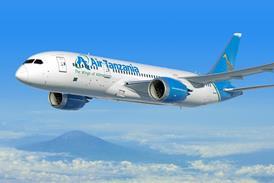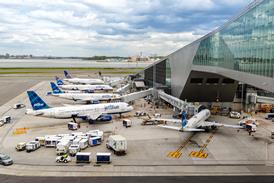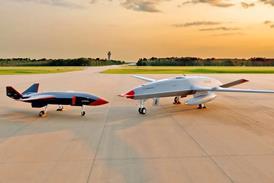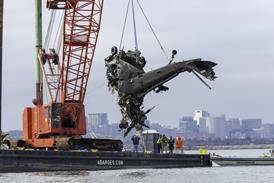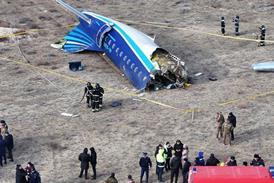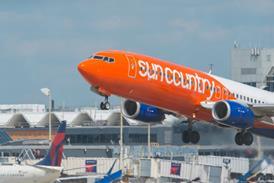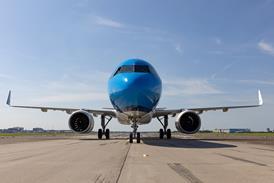China has emerged as a manufacturing superpower in several industries but has failed to gain traction as an exporter of combat aircraft. Could this be about to change?
A fateful night in the skies above mountainous Kashmir hints that the world’s perception of Chinese combat aircraft may have reached a turning point.

Details remain elusive about the air battle during the night of 5/6 May, when New Delhi launched attacks against suspected militant locations in Pakistan. Overseas officials have said that dozens of combat aircraft were involved on both sides, launching beyond-visual-range air-to-air missiles (BVRAAMs) across the night sky at distant targets.
The Indian air force reportedly used its most advanced fighter, the Dassault Aviation Rafale, to launch MBDA SCALP-EG cruise missiles. The Rafale has been an export superstar for France, with Dassault boasting about its combat record.
The Pakistan air force reportedly sent up its new – but entirely untried – Chinese fighter, the Chengdu J-10C, along with locally-produced Chengdu/Pakistan Aeronautical Complex JF-17s. Rumours circulating online suggest the Chinese jets were backed by a robust kill chain that apparently proved more than a match for India’s fighters, with evidence mounting that one or more Rafales was downed by long-range PL-15 BVRAAMs fired by the J-10C.
Without being specific, New Delhi admitted that losses are a part of warfare and only said that all pilots had returned home. It neither confirmed nor denied losses, letting nameless overseas officials and speculation fill the void.
Pakistan, for its part, claims five or six ‘kills’.
The idea that China-backed Pakistan has a decent kill-chain capability has merit: for over a decade Chinese defence companies have promoted the linking of manned aircraft, unmanned aircraft, and weapons in highly redundant “kill webs”. It is too soon to make any conclusions about the events of early May, but there has been a discernible shift in perceptions about Chinese fighters and technology.
The apparent strong performance of the Chinese jet, which is believed to be as effective as advanced versions of the Lockheed Martin F-16, could point to the increasing maturity of Chinese aircraft, sensors, air-launched weapons, and datalinks. It is believed that Pakistan’s J-10s may have been cued by airborne early warning and control (AEW&C) aircraft, such as the Erieye radar-equipped Saab 2000 or Xian Y-8.
Should more firm news emerge – and if the J-10C did indeed perform as claimed – it could be a boost for Chinese fighter exports. The news from India and Pakistan also comes at a time when Chinese combat jets are increasingly powered by Chinese engines. Combat effectiveness and technological autonomy could help Chinese fighters win sales beyond Pakistan and the random collection of developing nations that already buy its combat aircraft in small numbers.

Siemon Wezeman, a researcher on arms transfers at the Stockholm International Peace Research Institute (SIPRI), is of the view that the events of early May do not mark a turning point for Chinese aircraft.
“Obviously there is very little one can learn from such a limited clash in time and scope, and even less for lack of a complete picture of what happened and why it happened,” says Wezeman.
“No doubt China can now produce weapons that are – or seem on paper – to be on par with many Western weapons, but exporting them still runs into hurdles.”
Traditionally, a critical hurdle for China breaking into more prominent fighter export markets is the presence of Russian engines, such as the Klimov RD-93 that the powers the JF-17, or the NPO Saturn AL-31 that powers earlier versions of the J-10.
Russia, says Wezeman, could be reluctant to provide engines for Chinese aircraft in markets where it may see an opportunity to sell its own fighters. Pakistan is an exception: while New Delhi, a major buyer of Russian arms, might be annoyed at the Russian origins of the JF-17’s engines, it would be far angrier if Moscow were to sell complete aircraft to Pakistan. The J-10C is powered by China’s most mature fighter engine: the WS-10.
More important, Wezeman observes that the USA takes a dim view of nations buying high-end Chinese equipment, effectively blocking Chinese combat jets from the most lucrative defence aerospace markets.
Historically, China’s most successful combat aircraft export is the Chengdu F-7, a licence produced copy of the of the Mikoyan MiG-21.

Cirium, an aviation analytics company, suggests that some 488 F-7s were exported to 12 countries. The type appealed to nations with limited defence budgets and rudimentary needs. Like its MiG-21 cousin, the F-7 is relatively easy for unsophisticated air forces to maintain. A range of upgrades such as better sensors and cockpits are also available. Some international F-7 operators are understood to have incorporated Western and Israeli systems, such as the Elta Systems EL/M-2032 radar.
Major F-7 users include Pakistan, Bangladesh, North Korea, and Myanmar. Several African nations still use the type. Egypt, formerly a major operator, has retired its large fleet of 80 F-7s. Other operators are reportedly phasing out the type for obsolescence reasons. F-7 production ceased in 2013.
The JF-17 was intended as China’s breakthrough export star, offering a sophisticated combat aircraft at a relatively low-cost. The aircraft is pitched as a replacement for older types such the MiG-21, Dassault Mirage 5, Northrop F-5, and Chinese models such as the Nanchang A-5 and F-7. But despite its early promise and strong marketing efforts international sales appear to have fallen short of expectations.
During the 2010s the Pakistan air force played a major role in promoting the single-engined type, with appearances at major air shows such as Zhuhai, Dubai, Paris, and others. In addition to talking up the type’s capabilities with foreign media, Pakistani officials – who tend to be far more talkative than their Chinese counterparts – frequently created headlines by talking about the number of countries apparently interested in the jet.
At the Zhuhai air show in November 2010, a senior official of the China National Aero-Technology Import and Export Corporation (CATIC) confidently told FlightGlobal that serious discussions for the JF-17 were underway with no less than eight countries. Four years later, CATIC still had no JF-17 sales beyond Pakistan, but insisted that discussions with eight countries were still underway. Confirmed sales, it claimed, had been delayed by the Arab Spring uprisings against Middle East autocracies.
The JF-17 ended up landing some sales beyond Pakistan, but its customer list is not – and likely never well be – a who’s who of top air forces. Cirium indicates that Pakistan is by far the largest operator, with 150 examples in service and 33 on order. The other operators are Myanmar, with seven in service and nine on order, and Nigeria, with three in service.
Azerbaijan may also be a JF-17 operator – or is at least on the verge of becoming one. In September 2024 the nation’s president said the type had been “integrated” into the country’s air force. Reuters also reported that a contract had been signed.
Argentina was reportedly close to obtaining the JF-17, but in 2023 Washington, DC approved the third-party transfer of used Danish F-16s, denying Beijing of a high-profile defence sale in South America. Malaysia considered the aircraft for its trainer/light combat aircraft requirement, but this deal went to the Korea Aerospace Industries FA-50. The JF-17 has also been promoted to Iraq.

Arguably China’s biggest fighter export success in recent years has been the adoption of the J-10C by Pakistan – the export variant of the type is designated J-10CE. The jets were first inducted into the Pakistan air force’s No 15 Sqn in March 2022. Cirium suggests that 20 examples have been delivered, with five more on order.
Images of Pakistani J-10Cs shows that in addition to carrying air-to-air weapons such as the PL-10 and PL-15, they can be equipped with advanced ground attack weapons, such as the CM-400AKG supersonic missile, which can engage surface targets and ships. Another key weapon is Pakistan’s locally-developed Irek anti-radiation glide bomb – presumably this capability is available for other export customers.
Most recently, CATIC promoted the J-10CE and other combat types at the LIMA defence show in Langkawi, Malaysia. China’s defence ministry even issued a statement noting that a model of the type was on display at the show. The statement made no mention of the recent events over the Indian subcontinent, but the ministry clearly wanted to single out the type for extra attention.
Indeed, online sources have indicated that there is a third customer for the J-10C, but its identity is not clear. Countries that have reportedly considered the J-10CE include Bangladesh, Colombia, and Egypt.
Of these nations Egypt could be a key test case. The recent “Eagles of Civilization 2025” air force exercise between the two nations saw Beijing dispatch six J-10C/S fighters that performed sorties with Egyptian RAC MiG-29s. Other assets included a Shaanxi KJ-500 AEW&C aircraft, five Xian Y-20 strategic transports, and at least one Y-20U tanker. Harbin Z-20 helicopters were also sent to provide combat search and rescue cover.
Indonesia, which has expressed interest in an eclectic range of fighters, has also reportedly not ruled out a J-10C acquisition.
Intriguingly, Egypt is also reportedly interested in the new Shenyang J-35A, a low-observable aircraft that had its official debut at the Zhuhai air show in November 2024. The twin-engined fighter resembles the single-engined Lockheed F-35 and will be adopted by the People’s Liberation Army Air Force.
In May, a senior official at AVIC said that the jet is designed to deal with “high-level” threats such as stealth aircraft and will play a starring role in Chinese kill chains. Notably, AVIC has brought models of the J-35 (designated FC-31) to air shows for years, suggesting that it is being promoted for international customers.
It may be some time before China comes into its own as a major combat aircraft exporter, but it will take just one or two high-profile sales of a type such as the J-10C or J-35A to forever change perceptions about Chinese jets. Moreover, China can also offer key enablers such as AEW&C aircraft and tankers, all designed to work together.
Recent events over Kashmir may not have been a historic turning point for Chinese combat aircraft, but they have brought that day closer.

